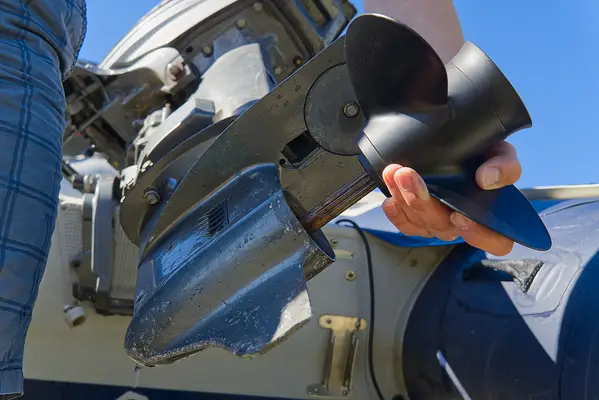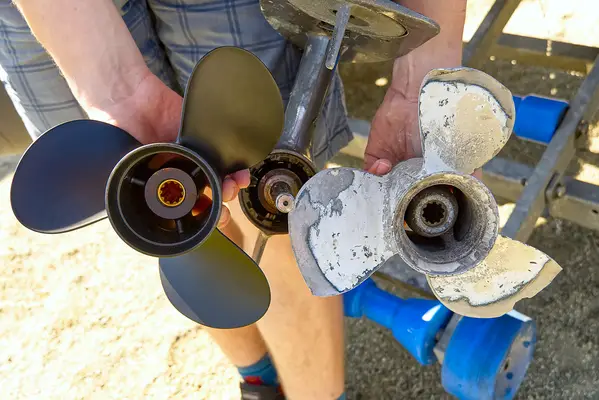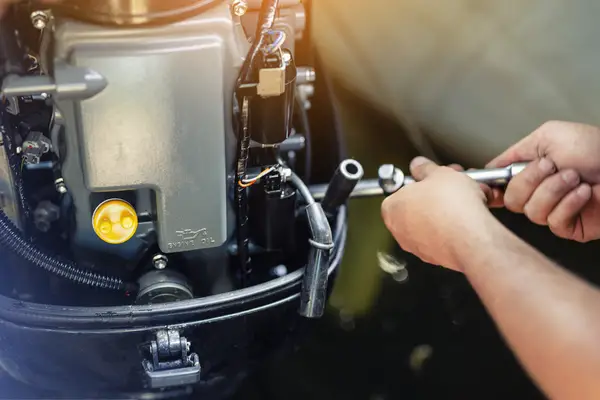Is your boat going in gear but the prop won’t spin? While this is frustrating, it can also be a potentially dangerous situation. So what can you do?
A handful of steps are required to troubleshoot propeller issues, such as checking the shift lever, throttle, and propeller shaft.
Some troubleshooting tips might require the boat out of the water, such as engine and transmission alignment, inspecting the propeller, and issues with the transmission.
Table of Contents
Spun Prop
The most likely cause of the engine going into gear without any spinning from the prop is a ‘spun prop’. This happens when the hub inside the propeller fails, causing the propeller shaft to spin without engaging the prop.
Signs You May Have A Spun Prop
- The engine goes into gear and revs loudly, but there is little or no forward motion.
- Grinding sounds, or erratic noises coming from the propeller.
- The prop does not spin in forward or reverse, even when the engine is in gear.
- Pieces of rubber, or metal shavings coming from the center of the propeller.
- The engine reaches high RPMs, but the boat can exceed idle speed.
What To Do If You ‘Spin A Prop’
If you’ve spun your prop while out on the water, you will most likely have to idle back to the ramp slowly. Do not exceed an idle speed, as this may cause further damage to the prop shaft or engine.
To repair a spun prop you will need to remove the propeller, inspect the shaft for any damages, and replace the propeller hub. Contact your boat manufacturer to find out the exact part and size of your outboard engine.
In most cases, replacing the propeller hub on the spun prop is an easy job that can be done at home with basic tools. However, it’s important to follow manufacturer specifications, and always best to have a marine mechanic inspect for further damages.
Other Troubleshooting Tips
Look at the Shift Lever
One of the simplest troubleshooting tips for the prop not spinning is the shift lever. You want to make sure it is engaged all the way.
In fact, this is one of the easiest fixes and most common mistakes boaters make.
You can engage forward or back to test this and do it manually without the cables. When doing it manually, check to see if it moves back and forth in gear at the engine.
If the boat goes into gear but makes a heavy clunking sound, you will need to worry about the driveshaft. If there is no sound, then it might be that the shifter is disconnected from the shaft or the controller.

If you put it in reverse and can hear it shift, then it might be a coupler issue. If no sound for reverse, then it could be the shifter.
Look at the Throttle
After checking the shift lever, try messing with the throttle. Some boats act differently if the throttle is not up to a certain amount.
In addition, some things affect the throttle and could mess with the prop. These include:
- Clogged fuel filters
- Bad impeller
- Poor quality of gas
Look at the Propeller
The propeller itself might be the cause of your problems. If the propeller has been damaged or is bent, it will not be able to spin correctly.
If you are able to remove the prop, inspect the inner and outer hub where the prop sits. Make sure this is free from debris and see if there is any damage on the inside.
If the prop has come loose or is too tight, this will affect the propeller’s ability to spin properly.
Furthermore, make sure there is no debris or something lodged in the prop. A simple fishing net or broken lines are enough to stop a prop from spinning.
Inspect the Propeller Shaft
This is where things can get dicey on issues with your propeller. The propeller shaft might be the issue, not the propeller.
The shaft is powered by the engine and it might have something preventing it from obtaining power. If it happens to be bent or damaged, it can definitely stop the prop from turning. One simple way to check is to rotate it by hand.

If the prop shaft appears to be stuck or has some resistance, the shaft could be the issue.
On the other hand, the propeller shaft being too loose is also an issue. Check to see if all of the shaft coupling bolts are still intact and tightened.
If you notice bolts and washers missing, or bolts sheared off, you will need to have the transmission and engine alignment checked since there may be a misalignment.
This can happen just from normal use or even improperly torqued when the boat was at the factory.
Check the Motor
If your motor is not letting water drain, you have an issue. You will need to make sure that the engine is off and look for anything that is blocking the water intake.
This could be weeds, lines, or other trash. If your motor is not intaking water like it should, it can cause the engine to overheat, which can cause issues with the prop.
Inspect the Engine
If you have made it this far in troubleshooting, the next step is to inspect the engine. One potential problem could be that the engine is low on fuel to run properly.
While this should likely be your first check, most forget to check fuel when their boat suddenly stops moving and fear the worst.
Other issues from the engine could be a clogged fuel filter or a bad fuel pump. These will need to be checked too in order to rule out routine maintenance issues.
Another troubleshooting tip on the engine is to check the spark plugs.
Spark plugs are necessary to help the engine run efficiently and the prop will not spin if they are weak or damaged. Consider checking them out once a year or every 100 hours.

Inspect the Drive Belt
If both the prop shaft and prop are in quality condition, it is time to check the drive belt. The drive belt is the transfer of energy from the engine to the transmission.
If this is worn out or has become damaged, it will not allow the propeller to turn. It is recommended to change these after 2,000 hours or before a long journey at sea.
If the belt is new, it might need to be tightened again after the first 50 to 100 hours.
Inspect the Transmission
Once you have checked the drive belt, it is time to mess with the transmission. The transmission has a very important job, which is to transfer power from the engine to the prop.
So if this is not working, you can see why your prop is not moving. Sources such as BoatU.S. recommend checking your transmission fluid levels are where they need to be.
If the fluid is thick like milk, it means it has been contaminated by water. If it has a burned smell, it is time for a trusted mechanic to inspect it. You should change the fluid every six months to a year, depending on use.
Contact a Trusted Mechanic
If you have tried everything under the sun to get your prop working again, it is time to contact a mechanic you trust.
If it happens to be something simple, the best thing to do is to make sure you are on top of your preventative maintenance.
You May Also Like: The Ultimate Gift List For Boat Owners

Growing up in Florida, I’ve been surrounded by saltwater my entire life…and I love sharing my passion with others.
To learn more about why I started Saltwater Mecca, visit the ABOUT page.
Thank you for reading this article. Browse around & have some fun!